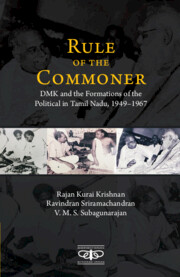9 - The Grassroots
Published online by Cambridge University Press: 15 June 2022
Summary
The most remarkable part of the DMK history is theincredible energy that went into grassrootsmobilization, which has remained so elusive to beingcaptured gainfully by the theoretical or analyticallens. We have already noted in Chapter 2 thesacrificial figure of Kilapaluvur Chinnasamy as anexemplar of the spirit of self-immolation thatCharles Taylor invokes in discussing the newer formsof the transcendental aspirations or moraldispositions in the age of modern politicalimaginary. However, such extreme acts of sacrificeshould not distract us from the predominantlypragmatic and programmatic aspects of associationallife, social mobility, and political empowermentthat characterized the lives of hundreds ofthousands of Dravida Munnetra Kazhagam (DMK) partyworkers at grassroots level all across the state inthe eighteen-year period of our study. However, itis obviously impossible to condense qualitatively,let alone measure quantitatively, the myriad formsthe grassroots mobilization assumed in the period,though this precisely is the most significant aspectof history. It should be possible to write anethnographic account of the history of theorganizational formation in a given place but thatwould demand a book-length narration.
When that is the case, to pick from the extensivematerial of ethnographic accounts we mobilized fromvarious locations in a short chapter like this islikely to render it purely anecdotal. For the sakeof brevity, we opt to provide a synoptic overview asan extraction of salient features from all thatmaterial, ethnographic and archival, in which wewill study the phenomenon under five distinctrubrics: the historicalbackdrop, the newsociality, theorganizational structure, fostering of politicalculture, thepolitical insurmountable, and finally acase study which would illustrate all of these.
THE HISTORICAL BACKDROP
It will be useful to conceptually segregate threedistinct dimensions of the formations of thepolitical to begin with: civil societyorganizational formations; discursive formationsthat include both ideational synthesis and diffusearticulations; and finally, popular uprisings,protest events of mass participation, organizedagitations, electoral victories, and so on. Itshould be borne in mind that these three dimensionsare not always welded together; it will often bedifficult to ascribe causal relationships and strictcorrespondences between them, as Shahid Amin hasconvincingly shown in his abundantly illustrativeaccount of the Chauri Chaura “event” in 1922 (Amin1996). More importantly, it would be misleading toidentify one for the other.
- Type
- Chapter
- Information
- Rule of the CommonerDMK and Formations of the Political in Tamil Nadu, 1949–1967, pp. 177 - 200Publisher: Cambridge University PressPrint publication year: 2022

